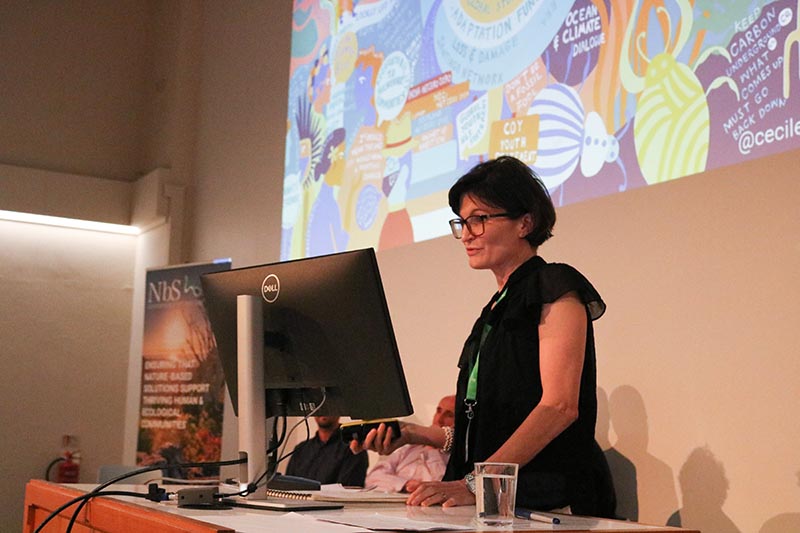NbS Conference 2022 – Day three summary
Thursday 7th July was the third and final day of the Nature based Solutions Conference 2022. As with day 2, there were parallel sessions in the afternoon across both the Natural History Museum and Oxford Martin School, with a diverse range of speakers and audience members in-person and online. The first two sessions focussed on […] July 8, 2022
Thursday 7th July was the third and final day of the Nature based Solutions Conference 2022. As with day 2, there were parallel sessions in the afternoon across both the Natural History Museum and Oxford Martin School, with a diverse range of speakers and audience members in-person and online.
The first two sessions focussed on the economics of NbS. In the opening plenary it was argued that the underpricing and underfunding of nature are significant failures of our economic and political systems. The proposed solution was phasing out environmentally harmful subsidies, estimated at around US$1.8 trillion per year; taxing activities that degrade the environment; and using the savings made and revenues generated to conserve and restore ecosystems. This could help bridge the significant funding shortfall – up to US$890 billion per year– required to implement NbS to overcome our environmental challenge. There is a long way to go, however, and it was noted that private financing of nature conservation and restoration is only at $6 billion per year.
Session 7 further explored some of these themes, and suggested the need for a new economic paradigm that looks beyond just GDP, uses more dynamic means of economic modelling and analysis, and takes an inclusive perspective, recognising value systems and behaviours cannot be entirely captured through monetary valuation. A number of interesting case-studies from South Africa, India, and Peru were then presented, highlighting, for example, how NbS can resolve environmental challenges extremely cost-effectively, and could play an invaluable role in economic recovery post-pandemic.
The first of the day’s parallel sessions, 8A, discussed the role of NbS in ensuring sustainable, resilient provision of food and water. Many cases were highlighted where NbS can be positive for food production and water security, but the need to consider wider trade-offs was also emphasized. Detailed, spatially and temporally explicit analysis is required as we implement NbS anticipate and reduce any trade-offs, and ensure there are net benefits. The challenge is stark: it was observed up to a million species are at risk of extinction in Africa alone, and the ecosystem degradation resulting from this biodiversity loss already shows negative consequences for carbon sequestration and hydrological functioning. This scale also means there are enormous opportunities, however, with one speaker noting that around 40% of South America is used for beef production, and often in degraded, low productivity pastures, where implementing NbS could help recover ecosystems and facilitate regenerative agriculture, with significant benefits for nature and food provision.
Over in the Oxford Martin School, session 8B on scaling up NbS in the UK explored the national context, discussing the role of the UK government, and highlighting a number of local case-studies. While a number of projects already demonstrate the valuable role NbS can play in the UK, there are challenges in transferring this knowledge and helping implement best practice elsewhere. A number of speakers also expressed frustration with the lack of policy coherence, making it hard to integrate NbS in broader plans despite significant enthusiasm. Similar uncertainties raise concerns in relation to private finance for NbS too, with farmers and land-owners interested in carbon and biodiversity credits, but cautious over the lack of clear or robust standards in offset markets.

NbSI’s Cécile Girardin chairing Business, Biodiversity and NbS
Session 9A continued further on the theme of business, biodiversity and NbS. The speakers indicated that carbon markets could, in principle, drive investment to ensure sustainable NbS that provide the greatest social benefit, but at present there is a lack of transparency and integration across supply chains. Concerns were raised over whether companies were primarily interested in NbS for ‘greenwashing’ – investing for marketing purposes rather than ensuring they do actually provide significant benefits for people and nature – but recognised that there are businesses making genuine efforts to reduce their environmental impacts. There was a consensus that developing robust, transparent indicators and monitoring programs will help overcome this problem, but it was also argued that we should not wait for the perfect metrics to be developed and delay implementation of NbS.
In session 9B, on mainstreaming NbS for urban sustainability, the importance of cities was made clear: half of the world’s population already live in urban environments, and the concentration of population and economic assets in these areas mean that natural disasters are particularly damaging in cities, but NbS could provide important options for mitigation and enhancing resilience. Meanwhile, it is increasingly demonstrated that access to nature is vital for health, well-being, and poverty reduction, hence deploying urban NbS can offer a range of benefits. Community co-design and co-management was highlighted as key to ensure long-term success of NbS, but it was noted that there is often a lack of long-term monitoring and maintenance.
Finally, Prof Seddon wrapped-up the conference, drawing out overall themes that had emerged from the conference. She noted the incredible enthusiasm for NbS evident across a range of sectors, and how it is already clear that deploying NbS could help address a number of critical challenges. Moving forward, priorities for the NbS include continuing to build the scientific evidence base and identify best practices, particularly in how to build collaborate approaches reflecting the knowledge and worldviews of indigenous peoples and local communities. All that was left was to thank those who had made the conference such a success: the organisers, the tech support, and the Natural History Museum and Oxford Martin School teams who hosted the in-person sessions. And of course the speakers, for providing an excellent range of talks and discussions, and the delegates for proving such an insightful and engaged audience.
